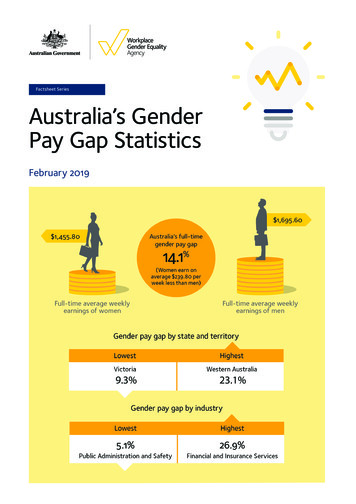
Transcription
Felipe Estrada, Anders Nilsson & Olof BäckmanThe gender gap in crime is decreasing,but who’s growing equal to whom?1AbstractThe declining gender gap in crime, observed in many Western countries, including Sweden, isoften interpreted as showing an alarming shift in the offending of young women. Explanationsto the observed pattern are often based on an assumption that women are increasingly coming tomimic the criminal behaviour of men, while we in this essay argue that to the extent behaviouralchange is at play, it is rather the other way around: men mimic women’s behaviour.Keywords: Gender gap, Crime trends, EqualityThe sex ratio in crime varies widely from one nation to another / / If countriesexisted in which females were politically and socially dominant, the female rate,according to this trend, should exceed the male rate. (Sutherland 1947:100)It is now more than forty years since Adler et al. noted, in their widely cited book”Sisters in Crime” (1975) that the gender gap in crime had become smaller, which theyfelt might be explained by reference to women’s emancipation. The fundamental thesisis that men’s behaviour constitutes the norm, which women will sooner or later cometo emulate even in relation to crime. One natural, but rarely posed, question is whyincreased gender equality should lead to a decline in the gender gap via an increase infemale involvement in crime and not instead via a decrease in male offending.Over recent years, the debate on the declining gender gap has once again becometopical. The central question is what is producing the declining gender gap in registeredcrime. Is it, for example, due to the registered offending of women having increased,while that of men may have decreased, as a result of behavioural changes linked to theliberation of women and men from traditional gender roles? An alternative explanationinstead refers to a reduced tolerance in western societies towards crime in general andviolence in particular. Against this backdrop, the declining gender gap may be under1 This essay builds on Estrada, Bäckman, Nilsson (2016): ”The Darker Side of Equality? TheDeclining Gender Gap in Crime: Historical Trends and an Enhanced Analysis of Staggered BirthCohorts.” British Journal of Criminology, vol 56 (6): 1272–1290.Sociologisk Forskning, årgång 54, nr 4, sid 359–363. Författaren och Sveriges Sociologförbund, ISSN 0038-0342, 2002-066X (elektronisk).359
SOCIOLOGISK FORSKNING 2017stood as being the result of a net-widening process with regard to which behaviourssocieties are choosing to react to and to prosecute through the justice system. Giventhat women account for a larger proportion of minor offences than of serious crimes,this type of net-widening process will affect the registered crime levels of women morethan those of men (Steffensmeier et al. 2005).The literature on the changing gender gap in crime has primarily focused on thesituation in the USA. At the same time, there is nothing to say that the hypotheses onnet-widening or a changed propensity for crime among women should not be relevantin other countries. To the extent that the ”emancipation hypothesis” is important forunderstanding the declining gender gap, Sweden constitutes a reasonable case to study.It is easy to find empirical support for the argument that Swedish society lies at the forefront of trends towards increased emancipation among women and increased genderequality. Although Sweden still falls considerably short of complete gender equality,the country is probably counted among those that come closest to the hypotheticalsituation described by Sutherland in the quotation above.The current studyOur objective is to elucidate the way the gender gap in crime has changed. In thisarticle we present long historical time series on the gender gap in theft and violentcrime. In our original study we have also looked at convictions of different birthcohorts and examined whether the change in the gender gap is general or whether itcan be specified to a certain age or to specific categories of theft or violent crime. Mostof our findings refute the hypothesis that the declining gender gap in crime is due toan increasing number of women committing offences.On the basis of long historical time-series describing trends in the gender gap for theftand violent crime in Sweden, we can show that the period subsequent to World War II isunique (Figure 1a–1d). During this period, the gender gap has undergone a continuousand substantial decline. At the same time, the declining gender gap in crime has beenproduced by different processes during different parts of this post-war period. Duringthe first half of the post-war period, the process is characterised by relative differences,i.e. women’s registered crime increases from significantly lower levels than those foundamong men, whereas recent decades are instead characterised by absolute differences inthe trends among men and women respectively. The trends of the first post-war decadesthus do not require the same type of gender-specific explanations as those of the mostrecent 30 years. It would appear more reasonable, for example, to explain the increasesin crime noted among both sexes during the first post-war decades as being due to achange in the opportunity structure that affected both men and women than it would toargue that increased equality (Adler et al 1975) was what was pushing both women andmen to commit more offences. Thus for the debate regarding the value of the emancipation hypothesis, and that regarding the relative significance of behavioural change andsociety’s reaction to crime respectively, the central issue becomes that of how the trendswitnessed since the beginning of the 1980s should best be understood.360
Felipe Estr ada, Anders Nilsson & Olof BäckmanFigure 1a–d. Number of convictions for assault (1866–2012) and theft (1841–2012) per 100,000of population. Men and women, and the gender gap ratio (men/women). Five-year movingaverages.The most important driving force in recent times is the powerful decline in thenumber of men convicted of crime. An additional analysis (Estrada et al 2016) of threecohorts born in the 1960s, 1970s and 1980s allows us to add that the gender gap hasonly declined substantially during one particular period of the life course, specificallythe later teenage years (age 15–20). When we look more closely at what types of crimethe youths from the three cohorts are convicted for, the data suggest that the declininggender gap is due to an increased inflow of minor types of theft and violent crime.These findings are in line with what might be expected as a result of crime policy trendscharacterised by net-widening (Steffensmeier et al. 2005).361
SOCIOLOGISK FORSKNING 2017It is likely that these trends have produced a situation in which a larger proportionof young women are starting adult life with a criminal record, and for offences forwhich they would not previously have been convicted.Finally, to the extent that the emancipation hypothesis and increased gender equality constitute a relevant explanation, this should be viewed in relation to the generalcrime trends that have characterised this period, which have taken the form of a visiblecrime drop rather than increasing crime levels. For those who still wish to focus onbehavioural changes, rather than changes in society’s reaction to crime, it would todayseem more fruitful to focus on the gendered nature of the crime drop rather than onthe causes of continually increasing crime among women. We would argue that theparadox here is that arguments focused on gender equality may have potential as ameans of explaining why men’s crime levels are moving towards those of women, ratherthan the reverse. The feminist criticism of the way men’s behaviour is regarded as thenorm tells us that there is nothing innate in men’s high levels of crime that womenwill sooner or later emulate. The low levels of crime found among women are of courseat least as ”normal” and are perhaps becoming ever more so in societies that are communicating an increasingly intolerant view of crime. This means that with increasinggender equality, the values and behaviour patterns that have traditionally been viewedas more feminine, many of which have an inhibitory effect on crime, may be spreadingto broader groups of men. Stated briefly, to the extent that increased gender equalitymay have affected the difference between men’s and women’s propensity for crime, itseffect may primarily be due to having produced changes in the type of masculinitythat encourages criminality.362
Felipe Estr ada, Anders Nilsson & Olof BäckmanReferencesAdler, F., Adler, HM.,, and Levins, H. (1975) Sisters in Crime. New York: McGrawHill.Estrada, F., Bäckman, O., and Nilsson, A. (2016) ”The Darker Side of Equality? TheDeclining Gender Gap in Crime: Historical Trends and an Enhanced Analysis ofStaggered Birth Cohorts.” British Journal of Criminology, vol 56 (6): 1272–1290Steffensmeier, D., Schwartz, J., Zhong, H., and Ackerman, J. (2005) ”An Assessmentof Recent Trends in Girls’ Violence Using Diverse Longitudinal Sources: Is theGender Gap Closing?”, Criminology 43: 355–406.Sutherland, E. (1947) Principles of Criminology. 4th ed. Philadelphia: Lippincott.Corresponding authorFelipe EstradaMail: felipe.estrada@criminology.su.seAuthorsOlof Bäckman is Associate Professor of Sociology at the Swedish Institute for Social Research (SOFI), Stockholm University. His research concerns poverty, crime andsocial exclusion in a life course perspective with a particular focus on the youth-toadulthood transition and on how social policy and other structural factors tap intosuch processes.Felipe Estrada is Professor of Criminology at the Department of Criminology, Stockholm University. His research focuses on life-course criminology, crime trends,and social exclusion.Anders Nilsson is Professor of Criminology at the Department of Criminology, Stockholm University. His research focuses on life-course criminology, crime trends,and social exclusion.363
the later teenage years (age 15-20). When we look more closely at what types of crime the youths from the three cohorts are convicted for, the data suggest that the declining gender gap is due to an increased inflow of minor types of theft and violent crime. These findings are in line with what might be expected as a result of crime policy trends










